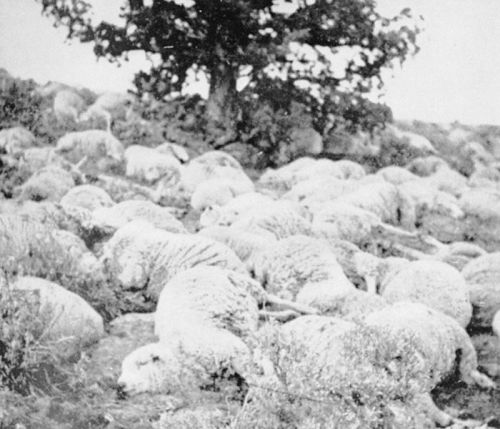peashooter85:The Sheepshooters War,Range wars and the Old West go together like peas and carrots, es
peashooter85:The Sheepshooters War,Range wars and the Old West go together like peas and carrots, especially range wars between cattlemen and sheepherders. During the later half of the 19th century cattlemen and sheepherders were always at odds as both forms of husbandry required a lot of open land. Cattlemen tended to fence of large plots of the open range while sheepherders were constantly on the move. Since sheep tend to consume the grass right down to the root, a flock of sheep can quickly and easily exhaust a plot of land. Thus sheepherders were constantly on the move, looking for new land and greener pastures. It was only a matter of time before the two groups came head to head, with one of them declaring, “dar ain’t enough room for the two of us.”In 1892 one of the strangest range wars broke out in Oregon where over 100,000 sheep competed for land with the cattle. When large parts of Oregon were turned into National Forests and State Parks, both cattlemen and sheepherders found they had less and less land to work with. Finally, tensions let loose when the cattlemen decided something had to be done. The cattlemen of Oregon banded together and formed armed militias to drive the sheepherders out of the state. However, unlike other Old West range wars the cattlemen did not harm any of the sheepherders, even swearing a pact that no man was to be killed in their endeavor. Rather, the cattlemen went right to the source; the sheep. The cattlemen would often sneak up on sheepherder’s camps, tying or otherwise incapacitating the sheepherders. They would then proceed to slaughter sheep by the hundreds and thousands. Many organizations claimed to have killed anywhere from 1,000 to 2,000 sheep in one raid. One organization called the Crook County Sheepshooters Association claimed to have killed around 8,000 - 10,000 sheep altogether. In another instance, a band of sheepshooters simply drove a flock of 2,400 sheep right off of a cliff. The law tried to step in, offering a $1,500 dollar reward for the information on any sheepshooters, but no one came forward.During the war there was only one supposed human casualty, a storekeeper named John Creed Conn. His death was ruled a suicide, despite the fact that his wounds were not self inflicted. Conn played no part in the war and most likely his murder was a separate incident, the range war being used as a cover for the killing. One sheepshooter was wounded by a stray bullet.The cost in sheep life however was staggering. Thousands of sheep were killed between 1895 and 1904. The height of the war occurred between 1905 and 1906, in which 10,000 - 15,000 sheep were massacred. It was then that the Federal Government stepped in to end the war. A range supervisor was appointed, who divided the land into plots on which only one user could use. With the land no longer open to public grazing, both cattlemen and sheepherders settled down and found more sustainable ways of raising their herds/flocks. No sheepshooter was ever identified and prosecuted. -- source link
Tumblr Blog : peashooter85.tumblr.com

